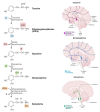Advanced Nanomaterials-Based Electrochemical Biosensors for Catecholamines Detection: Challenges and Trends
- PMID: 36831978
- PMCID: PMC9953752
- DOI: 10.3390/bios13020211
Advanced Nanomaterials-Based Electrochemical Biosensors for Catecholamines Detection: Challenges and Trends
Abstract
Catecholamines, including dopamine, epinephrine, and norepinephrine, are considered one of the most crucial subgroups of neurotransmitters in the central nervous system (CNS), in which they act at the brain's highest levels of mental function and play key roles in neurological disorders. Accordingly, the analysis of such catecholamines in biological samples has shown a great interest in clinical and pharmaceutical importance toward the early diagnosis of neurological diseases such as Epilepsy, Parkinson, and Alzheimer diseases. As promising routes for the real-time monitoring of catecholamine neurotransmitters, optical and electrochemical biosensors have been widely adopted and perceived as a dramatically accelerating development in the last decade. Therefore, this review aims to provide a comprehensive overview on the recent advances and main challenges in catecholamines biosensors. Particular emphasis is given to electrochemical biosensors, reviewing their sensing mechanism and the unique characteristics brought by the emergence of nanotechnology. Based on specific biosensors' performance metrics, multiple perspectives on the therapeutic use of nanomaterial for catecholamines analysis and future development trends are also summarized.
Keywords: catecholamine neurotransmitters; dopamine; electrochemical biosensor; epinephrine; nanomaterials; norepinephrine.
Conflict of interest statement
The authors declare no conflict of interest.
Figures










Similar articles
-
Electrochemical sensors and biosensors for determination of catecholamine neurotransmitters: A review.Talanta. 2016 Nov 1;160:653-679. doi: 10.1016/j.talanta.2016.06.066. Epub 2016 Jul 1. Talanta. 2016. PMID: 27591662 Review.
-
Conducting polymer-based electrochemical biosensors for neurotransmitters: A review.Biosens Bioelectron. 2018 Apr 15;102:540-552. doi: 10.1016/j.bios.2017.11.069. Epub 2017 Dec 5. Biosens Bioelectron. 2018. PMID: 29220802 Review.
-
Electrochemical Detection of Neurotransmitters.Biosensors (Basel). 2020 Aug 18;10(8):101. doi: 10.3390/bios10080101. Biosensors (Basel). 2020. PMID: 32824869 Free PMC article. Review.
-
Nanomaterial-based electrochemical enzymatic biosensors for recognizing phenolic compounds in aqueous effluents.Environ Res. 2022 Nov;214(Pt 3):113858. doi: 10.1016/j.envres.2022.113858. Epub 2022 Aug 8. Environ Res. 2022. PMID: 35952740 Review.
-
Recent advances in nanomaterial-based biosensors for the detection of exosomes.Anal Bioanal Chem. 2021 Jan;413(1):83-102. doi: 10.1007/s00216-020-03000-0. Epub 2020 Nov 8. Anal Bioanal Chem. 2021. PMID: 33164151 Review.
Cited by
-
Review on Surface-Modified Electrodes for the Enhanced Electrochemical Detection of Selective Serotonin Reuptake Inhibitors (SSRIs).Micromachines (Basel). 2023 Jun 29;14(7):1334. doi: 10.3390/mi14071334. Micromachines (Basel). 2023. PMID: 37512646 Free PMC article. Review.
-
Towards a Rational Design of Biosensors: Engineering Covalently Grafted Interfacial Adlayers as a Testbed Platform for Electrochemical Detection of Epinephrine.Molecules. 2025 May 21;30(10):2236. doi: 10.3390/molecules30102236. Molecules. 2025. PMID: 40430407 Free PMC article.
-
Dopamine-Coated Carbon Nanodots: A Supramolecular Approach to Polydopamine Composite.Int J Mol Sci. 2023 Oct 20;24(20):15384. doi: 10.3390/ijms242015384. Int J Mol Sci. 2023. PMID: 37895064 Free PMC article.
-
Applications of Novel Microscale and Nanoscale Materials for Theranostics: From Design to Clinical Translation.Pharmaceutics. 2024 Oct 18;16(10):1339. doi: 10.3390/pharmaceutics16101339. Pharmaceutics. 2024. PMID: 39458667 Free PMC article. Review.
-
A nanoplatform-based aptasensor to electrochemically detect epinephrine produced by living cells.Mikrochim Acta. 2023 Aug 4;190(9):343. doi: 10.1007/s00604-023-05902-z. Mikrochim Acta. 2023. PMID: 37540351
References
-
- Lončar A., Negrojević L., Dimitrić-Marković J., Dimić D. The Reactivity of Neurotransmitters and Their Metabolites towards Various Nitrogen-Centered Radicals: Experimental, Theoretical, and Biotoxicity Evaluation. Comput. Biol. Chem. 2021;95:107573. doi: 10.1016/j.compbiolchem.2021.107573. - DOI - PubMed
-
- Roondhe B., Jha P.K. Neurotransmitter-Functionalized Boron Nitride Nanoribbons as Biological Cargo Carriers: Analysis by Density Functional Theory. ACS Appl. Nano Mater. 2019;2:1552–1561. doi: 10.1021/acsanm.9b00028. - DOI
-
- Xie W., Yin Y., Gu R., Xu J., Su X., Wang Y., Liu R., Liu X., Huang J. Label-Free and Highly Selective MOFs-Based Dopamine Detection in Urine of Parkinson’s Patients. Chem. Eng. J. 2022;443:136371. doi: 10.1016/j.cej.2022.136371. - DOI
Publication types
MeSH terms
Substances
Grants and funding
LinkOut - more resources
Full Text Sources
Research Materials

